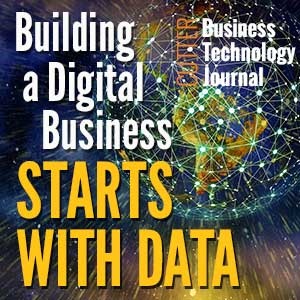When writing a first draft of my book Business unIntelligence in 2011, I coined the term “biz-tech ecosystem,” as follows:
The evolving environment where business is fully or heavily dependent on information technology for all activities. IT adopts the role of partner and co-creator in business innovation. Business completely values and engages the full potential of IT.
Although the biz-tech ecosystem didn’t resonate in the popular consciousness, I believe it better captures the essence of an emerging business environment than the competing — and now embedded — terms “digital business” and “digital transformation.” Their shared focus on digital dangerously narrows the vision of those tasked with the data implementation to which digitization applies. Indeed, there’s a lack of understanding of what might need to be implemented when it comes to both of these modern phrases. That a business should characterize itself simply as being digital feels more like analyst hand-waving than something that one could or should build. As for digital transformation, the absence of any indication of what must be transformed might pass for shoddy penmanship. It seems, therefore, that before discussing how to start building a digital business, we must first clarify what one is.
Defining Digital Business
The phrase “digital business,” along with “e-business,” dates to the last century — indeed, the last millennium — and the rise and fall of the dot.com era. By 2001, its meaning was already in need of clarification, as suggested by Adrian Slywotzky and David Morrison:
… to think of digital business design as the sum total of the high‐tech innovations multiplying around us is a fatally incomplete view…. The discipline of digital business design is not about wiring your workforce, converting your R&D to CAD/CAM, or selling products through your website. Instead, it is about using digital technologies to expand your company’s strategic options. It is about serving customers, creating unique value propositions, leveraging talent, achieving order‐of‐magnitude improvements in productivity, and increasing and protecting profits.
By 2016, in an issue of Cutter Business Technology Journal (CBTJ), Cutter Consortium Senior Consultant Borys Stokalski and Bogumil Kaminski described digital business transformation as:
A journey of creating and combining specific business capabilities so that they give organizations a competitive advantage in the digital excellence domains in a way that reflects their chosen mix of strategic options. This journey is shaped also by the availability of critical resources — data, analytical skills, technology proficiency.
This definition, and its focus on data and analytics, leads me back to my definition of the biz-tech ecosystem, which I propose as a synonym for a digital business:
A digital business is a business that is wholly or heavily dependent on all forms of information technology in all activities planned and undertaken to achieve its strategic business goals. Using this technology, a digital business can harvest data from all sources, internal and external. It can contextualize and combine this data into useful information, from which valuable insights can be derived and informed actions can be taken at greater speed and frequency than possible in a traditional environment. Its processes, people, and organizations are optimized to take advantage of all the information available and to operate and evolve with the speed and efficiency thus possible.
Where to Start Building a Digital Business
With this definition in hand, we are finally able to address the real question posed by this issue of CBTJ: what’s the best way to start building a digital business?
Given that digital business affects all activities in support of every strategic goal, it is immediately clear that implementing a digital business implies an enterprise-wide effort. Furthermore, all three traditional classes of IT — operational, informational, and collaborative — are equally in the sights of digital transformation. In addition, today’s Internet of Things (IoT) drives widespread and deep changes in operations, including extensive automation via artificial intelligence (AI) tools. Social media and highly mobile, tech-savvy customers are using new and extensive collaborative infrastructures to interact with businesses. Both these changes mandate significant new decision-making support using analytics, machine learning, and more. Enterprise-wide change of such scope is notoriously difficult to manage and succeeds only through a best-of-breed, cross-enterprise collaborative and change management effort.
Moreover, the old systems must be kept running and maintained even as IT turns toward new horizons. Of course, this is not a new problem. A variety of approaches have been proposed since the 1990s. These range from architectural (e.g., SOA) through methodological (e.g., Agile development) to organizational (e.g., bimodal IT). These seemingly distinct focus areas are not truly separate; they interact in often unforeseeable ways. More than 20 years’ experience has proven time and again that, of these three aspects, it is the organizational challenge that often proves fatal to progress.
It is clear, therefore, that before we can address questions of a conceptual and logical architecture for digital business, we must first consider enterprise-wide methodological and organizational concerns. The typical IT focus on and rush toward new technology and tools as “magic bullets” targeted on digital transformation is disturbing. In short, building a digital business is a major undertaking, reminiscent of that old saying often applied to migrations of ERP systems: “It’s like trying to change all four engines simultaneously on a 747 … in flight.”
Current experience building digital business is predictably disappointing. It is reported that 84% of digital transformation initiatives fail, and that a large proportion of those failures can be traced to an unwillingness of organizations, both business and IT, to change behaviors. As Cutter Consortium Senior Consultant Greg Smith et al. recently pointed out: “A significant proportion of failures to realize the anticipated value from digital transformations can be directly traced to failure to appreciate and address human behavior associated with the transformation.”
How then to proceed?
Starting from the Data Warehouse
The fact that digital business begins with enormous amounts of diverse data and information offers a clue to a possible approach. Collecting and processing big data is something with which we are already familiar: could data lakes be a starting point? While attractive from a technology viewpoint — new, fast-evolving tools promise to eliminate old bottlenecks — data lakes still pose significant data management and governance challenges. The experience of many excavators of data lakes is that they often end up in data swamps!
One — and perhaps only one — concept in the IT world addresses the ingestion of large quantities of data/information from multiple sources, consolidating it for shared use, and delivering it for enterprise-wide and increasingly real-time use. The data warehouse is that approach. And it benefits from three decades of thinking, development, and successful implementation. I argue the case for the data warehouse under three headings: technology, information/data governance, and enterprise-wide focus.
Technology, as previously mentioned, is not the core issue in building a digital business. However, let’s start by countering some key misconceptions about big data and data warehousing (DW).
Data warehouses traditionally handled volumes of data considered large for their time, until the advent of big data in the mid-2000s and more recently with the IoT. While the “3Vs” of big data (volume, variety, and velocity) still pose challenges to classic relational databases (RDBs) on which the data warehouse was based, advances in database technology and changes in DW practice mean these issues are now less of a concern than previously. Hadoop and NoSQL technologies in parallel processing and in-memory environments were developed in the last decade to counter the rigidity of structure and lack of scalability and performance of RDBs. Many of these techniques have since been embedded in RDBs; indeed, in many everyday big data circumstances across multiple industries, RDBs can support at least some of the core data processing and storage needs of a digital business.
Furthermore, most DW practitioners no longer believe that all data must be routed through a centralized enterprise data warehouse (EDW). Multiple storage and processing technologies are included in the data warehouse and direct access to data sources — data virtualization — is now encouraged. The need to support real-time decisions means that the balance of power between database storage and processing engines is shifting. In modern data warehouse architectures, the EDW is reserved for core business information that must be reconciled as a basis for enterprise-wide use.
This leads to the second aspect: comprehensive information/data governance. A digital business without it will fail and fail fast as unverified data is used for improper purposes, allowing multiple and inconsistent versions of truth about the business to proliferate. I use the term “information/data” rather than the more common “data governance” to emphasize the key role of the business meaning that must be assigned to data in a digital business. Data governance in traditional business — where most or all data is internally sourced and its meaning (mostly) is well defined — is challenging, and DW initiatives are often at the forefront of tackling these issues. The techniques and experience that DW teams have developed over the years will be invaluable in addressing the more complex and widespread challenges of governing data arriving at high speed and in high volumes from poorly understood or managed external sources and transforming it into useful, reliable information.
Governance addresses a fundamental issue: what is a true representation of the real world in the information systems of a business? As has become crystal clear recently surrounding the “fake news” dilemma, answering that question requires a human response, both individual and collective, and must be undertaken in a collaborative manner with collective shared interest and goodwill. Fortunately, within a business, we may expect that such virtues are more common than in politics.
Like information/data governance, enterprise-wide focus is an organizational rather than a technological issue. Successful DW program managers have long collaborated with all parts of the enterprise as they roll out a succession of projects. This alliance begins with the owners of data sources, who — even when internal — may set strict limits on what can be changed to meet new informational needs. The partnership extends to all potential users of warehoused information, who often do not know the use they will make of the information received until they see it. Thus, DW program managers become adept negotiators throughout the enterprise and at all levels of management to achieve their goals. The implementation of a digital business draws identical parallels.
Starting from a data warehouse just makes sense. Of course, the architectural thinking and technology offer valuable intellectual capital to IT. But the real value comes from the decades of experience in information/data governance and management, as well as the interpersonal and organizational skills that DW implementers have gathered. As you will see from the articles in this issue, the contributors are on the same path.
In This Issue
In our first article, Daniel Power, an expert in decision support systems since the early 1980s, and Ciara Heavin argue that adapting to the changing business environment of a digital business is about much more than implementing new technologies like analytics, the IoT, and so on. Rather, business managers from the boardroom down must drive the adoption and skilled use of data-based decision making. Ultimately, Power and Heavin believe that middle managers are critical to digital business — making data-based decisions and selecting tasks that provide the necessary capabilities to deliver on a digital transformation vision and strategy. Organizational change management and skills development for these managers are thus at the core of digital business implementation.
Next, Martijn ten Napel, a practicing architect in the field of business intelligence (BI) since 1998, explores the challenge that has confronted him throughout his career: why do so many BI projects fail? His conclusion is that the struggle to achieve coherence between people, process, information, and technology has caused the complexity of the data landscape to grow out of control. His answer to the problem is the connected architecture — a framework and thought process for the organization of DW and BI projects. He believes it applies equally to digital business.
In our third piece, we hear from Michael Müller, an architect consultant in BI for almost 20 years. Like ten Napel, his view is that managing change is essential for a digital business initiative. This position emerges from his experience with BI projects where “Babylonian confusion” reigns, as business and IT lack a common vocabulary and an ability to communicate clearly about data needs and structures. Müller posits that digital business shares these same characteristics, but at a much larger scale because of the nature of big data. He offers an overview of a pathway for creating and maintaining conceptual-level data models that may be useful to implementers of digital business environments.
In the final article, Pat O’Sullivan, an IT architect and Senior Technical Staff Member at IBM, starts from the premise that the principles of standardization and conformity that were developed for the data warehouse are equally applicable to a digital business to deliver a consistent view of information to many lines of business. He explores the characteristics of a system of common metadata that can define the links between an existing data warehouse and an emerging digital business, describing the components and characteristics of this new metadata layer and how it is essential to fueling the growth of the AI capabilities of a digital business.
Conclusion
The contributors to this issue of CBTJ are of a single mind that a data warehouse is indeed a good starting point for building a digital business. They are equally consistent in their view that it is the organizational skills and information/data governance approaches, particularly with respect to modeling, that are most central to benefiting from a data warehouse implementation when defining and building a digital business. For experienced DW practitioners, these conclusions will hardly be surprising. However, given the more diverse backgrounds of implementers of digital business, there are important and valuable takeaways from the analysis of our contributors. My sincere thanks to them for their time and energy in sharing their valuable knowledge and experience.
Building a Digital Business Starts with Data
This Cutter Business Technology Journal issue, Guest Edited by Barry Devlin, is available in the Cutter Bookstore. Save 20% with Coupon Code DigitalData20.
Cutter members: Access here.




